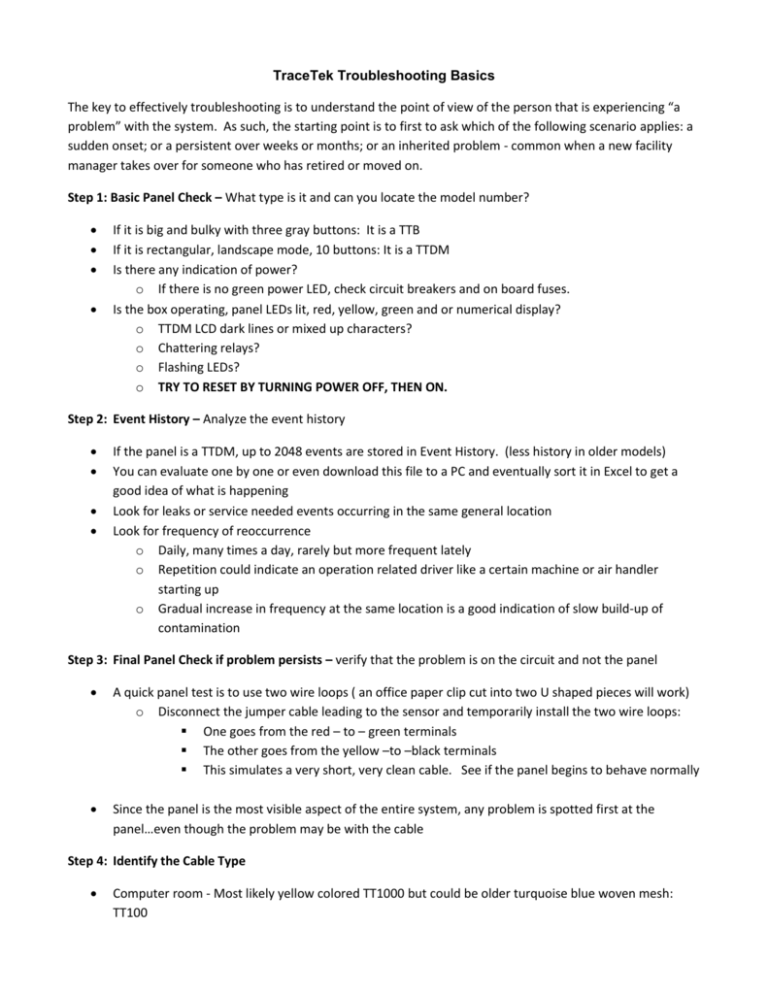TraceTek Troubleshooting Basics
advertisement

TraceTek Troubleshooting Basics The key to effectively troubleshooting is to understand the point of view of the person that is experiencing “a problem” with the system. As such, the starting point is to first to ask which of the following scenario applies: a sudden onset; or a persistent over weeks or months; or an inherited problem - common when a new facility manager takes over for someone who has retired or moved on. Step 1: Basic Panel Check – What type is it and can you locate the model number? If it is big and bulky with three gray buttons: It is a TTB If it is rectangular, landscape mode, 10 buttons: It is a TTDM Is there any indication of power? o If there is no green power LED, check circuit breakers and on board fuses. Is the box operating, panel LEDs lit, red, yellow, green and or numerical display? o TTDM LCD dark lines or mixed up characters? o Chattering relays? o Flashing LEDs? o TRY TO RESET BY TURNING POWER OFF, THEN ON. Step 2: Event History – Analyze the event history If the panel is a TTDM, up to 2048 events are stored in Event History. (less history in older models) You can evaluate one by one or even download this file to a PC and eventually sort it in Excel to get a good idea of what is happening Look for leaks or service needed events occurring in the same general location Look for frequency of reoccurrence o Daily, many times a day, rarely but more frequent lately o Repetition could indicate an operation related driver like a certain machine or air handler starting up o Gradual increase in frequency at the same location is a good indication of slow build-up of contamination Step 3: Final Panel Check if problem persists – verify that the problem is on the circuit and not the panel A quick panel test is to use two wire loops ( an office paper clip cut into two U shaped pieces will work) o Disconnect the jumper cable leading to the sensor and temporarily install the two wire loops: One goes from the red – to – green terminals The other goes from the yellow –to –black terminals This simulates a very short, very clean cable. See if the panel begins to behave normally Since the panel is the most visible aspect of the entire system, any problem is spotted first at the panel…even though the problem may be with the cable Step 4: Identify the Cable Type Computer room - Most likely yellow colored TT1000 but could be older turquoise blue woven mesh: TT100 Semiconductor or other industrial facility - likely to be orange colored TT3000 or could be very old TT300 (loose white braid) or black and white fiber jacket of TT5001 solvent sensor or very old TT501 Fuel related systems - look for red, white and black fiber jacket of TT5000 or Orange tube TT-FFS Step 5: Check for signs of wear and tear Long term installations (especially very old TT100 and TT300 cables often suffer from dirt and debris contamination) Is there a system map? o Do you know where the cable runs and the distances along the cable? o Sometimes the system has actually detected a leak but the user doesn’t know that the panel is telling him where to find the leak o TTDM panels can also tell the user when the cable is getting dirty with ”SERVICE REQUIRED” and make an estimate of where the contamination might be located…..but you need a map to convert distance read-out to location. Is the problem intermittent or always present? o Real leaks don’t usually disappear, but border line contamination may come and go as equipment cycles off and on Step 6: Ohm meter test - Resistance checks Disconnect the jumper cable and use the meter to check red-to-green and yellow-to-black resistance. o Both should be about 4 ohms x length of sensor cable in feet (jumper cable not included) High resistance (sometimes even an open circuit on one loop or the other , or both, is an indication of cable damage) One loop high and one loop low could be corrosion indicator or more likely a ground loop (more on this later) Measure black-to-green o A clean and dry cable should read OL or open circuit or at least more than 10 meg ohms A low number, less than 50K ohms, indicates a leak or contamination build up Measure green-to-ground and black-to-ground o Both of these measurements should read OL or open circuit or at least more than 10 meg ohms If either measurement is a low number, then the cable electrode(s) are making contact with metal connected to the building ground system: Drip tray sharp edges Floor jacks and threaded fittings Sensor cable crushed under metal conduit o If one of the electrodes is touching at more than one place then the loop measurements will not be balanced o If both electrodes are touching (perhaps at different locations), there will be a leak or service needed indication Contact with grounding metal can be intermittent with vibration or stop/start cycling playing a role. Cables shorted to ground must be cleared to ensure proper operation of the sensing circuit. Step 7: Perform a Visual Inspection Do the obvious first: check the location indicated on the panel for water, debris, indications of evaporated leaks (rust, salty areas etc.) Look for physical damage, evidence of recent construction o Ask what new equipment has been installed recently Discuss location averaging: o Just as a very large leak will report a location at the middle, two leaks on a cable will report an average location in between but the cable at the “average” location may be dry. Check EVENT HISTORY: The first indication of trouble is probably accurate, but if it has been ignored for days or weeks more and more events are confusing the picture. Go check the first area of trouble. Break the system into smaller pieces with the end termination and work outward section at a time. Special considerations when troubleshooting fuel cables If trouble is encountered with a TT5000 system, the original spill may have evaporated, but the cable is a good sponge and will smell like fuel for many days TT5000 is crush and heat sensitive. Look for pinched or crushed cable. It reports like a leak but there will be no fuel smell Fuel cable does not reset …unlike TT1000 or TT3000, in most cases TT5000 has to be replaced. Special considerations when troubleshooting Fast Fuel Sensors TT-FFS is a probe type sensor that monitors a sump or pit or floor area for fuel spills The sensor is an electronic off-on switch that is turned off or on by the presence of fuel on the sensor blade. Most fuels (even a thin film on water) will set it off and it can usually be reset But the sensor film itself can be damaged by scraping or poking and if the sensor film is damaged beyond use it “fails safe”. That is it generates a leak alarm and forces the customer to deal with the problem (usually replacement is required) SUMMARY Don’t assume it’s a panel problem - a quick two wire loop check can verify that the panel is OK. Look at TTDM event history; look for recent construction, new equipment or air handlers. If no leak found at location, break the system down with the end termination and tackle smaller segments one at a time. Fuel spills leave the cable smelling like fuel …. Despite what the customer claims A damaged FFS will report an alarm just like a leak so that it is not ignored. If following all these steps fails to solve the problem, call TraceTek (650) 474-7510







